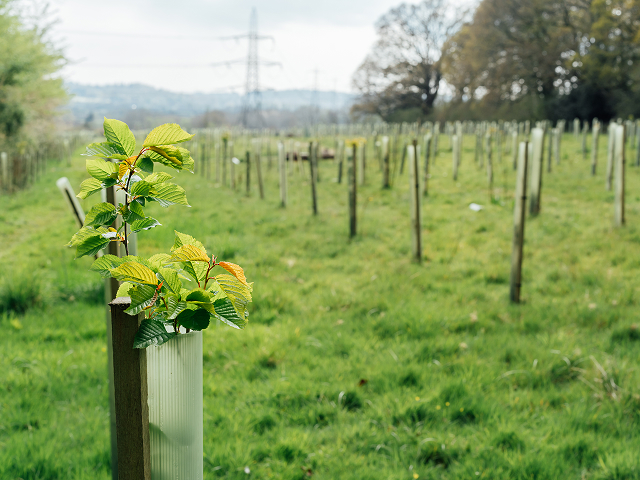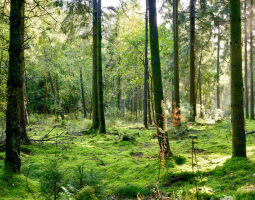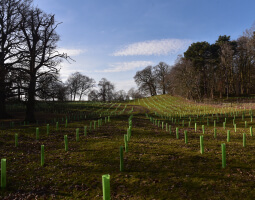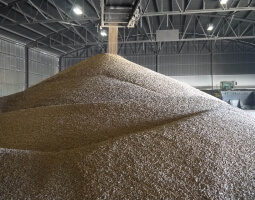Establishing New Woodland
New woodlands have the potential to sequester carbon, provided that the right tree species are grown in the right locations.
The potential for new woodland to sequester carbon and contribute to climate change mitigation has been well-studied. Trees can also have many other positive benefits such as supporting wildlife, providing shelter for livestock, preventing soil erosion, reducing flooding, providing timber, supporting the economy and improving peoples’ mental health and wellbeing.
Woodland Establishment Targets
The UK has an ambition to plant 30,000 hectares (ha) of new woodland annually from May 2024, and a statutory target to reach 16.5% tree and woodland cover by 2050- an increase of over 800,000 hectares (Forestry Commission, 2023). Together with improved management of existing woodlands, the Climate Change Committee (CCC) estimated that this could save annual greenhouse gas (GHG) emissions of over 12 million tonnes of carbon dioxide equivalent (MtCO2e) by 2050, plus up to an equivalent of 14 MtCO2 e per year retained as carbon in harvested materials. Combined, this equates to around 6% of current UK carbon dioxide equivalent emissions (2022 UK Greenhouse Gas Emissions, National Statistics).
A carbon dioxide equivalent or CO2 equivalent, is a measure used to compare the emissions from various greenhouse gases on the basis of their global-warming potential (GWP). See the carbon glossary for a more detailed explanation.
Forests in the UK remove large amounts of CO2 from the atmosphere and creating new woodlands offers the potential for offsetting CO2 emissions from other sources. However, even the most ambitious afforestation plans will only be able to offset a small proportion of total current national emissions, so large cuts in GHG emissions in other sectors are essential to achieve the UK net zero emissions target. As new woodlands generally take ten to thirty years to start to take up substantial amounts of CO2, there is an imminent need to establish new woodlands for them be able to contribute substantially to the 2050 net zero emissions target. Furthermore, beyond 2050 there will be a continued need for carbon removal to compensate for those sectors that are harder to decarbonise.
Establishing Woodlands to Sequester Carbon
Establishing woodlands to sequester carbon is not as simple as planting trees alone; it is essential that the trees grow well and are resilient to the impacts from the changing climate and risks from pests and diseases.
There is no single best option for forest creation and management for mitigating GHG emissions. Many factors affect the carbon balance of forests in different locations, and different types of forests can help reduce GHG emissions in different ways. Different site and climatic conditions can favour different tree species and influence potential tree growth rates.
The care and management of new woodlands is important for increasing initial tree survival rates and encouraging faster establishment. Site cultivation plays an important role in this, however more intensive methods of cultivation can have adverse impacts on carbon, soil and water. Therefore, the selected cultivation technique should be tailored to the site as the minimum required to ensure adequate tree establishment (Guidance on cultivation: operations note 53).
Not all sites are appropriate for forest establishment. For example, in areas of high soil carbon stocks there may be significant carbon losses during the woodland establishment phase, and the soil carbon stock may never return to its prior value. Some sites may have high biodiversity value, such as species-rich grasslands, which would be lost if converted to woodlands.
Tree planting could also have negative, indirect impacts on GHG emissions if land is taken out of food production for tree planting in one location, and consequently existing forests elsewhere are felled for conversion to agricultural land. Therefore, woodland establishment targets must be considered holistically with other competing demands and uses for land.
There are various resources of information and advice for woodland managers and landowners in the UK, including:
- Making certain that woodlands are compliant with the UK Forestry Standard (UKFS), thus enabling them to provide important environmental benefits while reducing the likelihood of the negative impacts that pests, diseases, natural disasters and other threats can have on woodlands.
- The Climate Matching Tool which can help practitioners consider suitable tree selections for their particular location.
- The Ecological Site Classification tool (ESC) which is a web-based decision support system that helps forest managers and planners select tree species that are ecologically suited to particular sites.


The Woodland Carbon Code
Before investing in afforestation projects, landowners may want to know how much carbon a scheme will sequester. The UK Woodland Carbon Code provides information on the carbon sequestration potential of new woodlands of different tree species and growth rates, planted at different spacings and managed with or without being thinned (see Carbon impacts of managing woodland).
The methods used have been independently verified, so that registering a woodland creation project with the Woodland Carbon Code can generate carbon units that can be sold to third parties to compensate for their carbon emissions or be used to offset the landowner’s own emissions.




